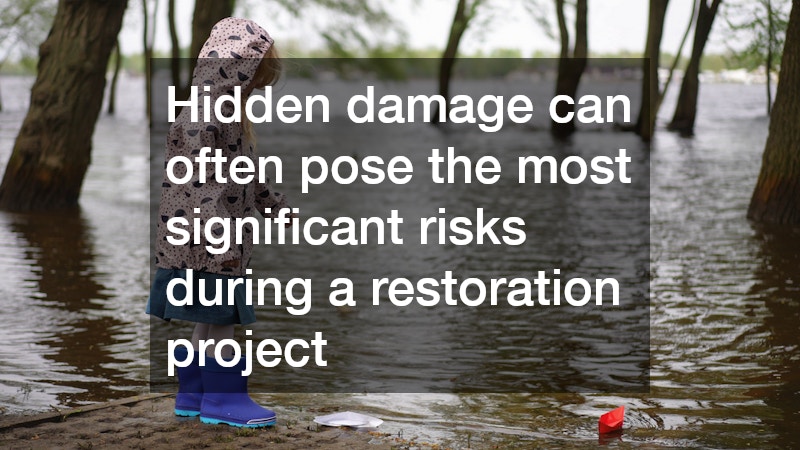There are various methods and processes used by a water and fire damage restoration company when assessing your home following an incident. Understanding these procedures can provide homeowners with valuable insights and help them navigate the restoration process more effectively.
Initial Steps
Upon arrival at the site, restoration professionals first conduct a thorough inspection of the property to identify visible signs of damage. This step involves assessing the areas affected by water or fire, looking for structural integrity issues, and noting any immediate hazards such as electrical dangers or compromised walls.
Their goal is to establish a clear picture of the incident’s impact on the property and its contents.
During the initial evaluation, restoration specialists often take photographs and detailed notes to document the damage meticulously. This documentation serves as a foundational record that will guide the restoration process and help communicate the extent of the damage to insurance companies, if needed. By maintaining precise records, restoration teams ensure that all relevant factors are considered in future assessments and recovery plans.
Finally, restoration companies will discuss their findings with the homeowner. This meeting helps ensure that the homeowner understands the situation and is aware of potential risks associated with the damage. Clear communication at this stage lays the groundwork for a collaborative approach to the restoration process, emphasizing teamwork and transparency throughout.
Hidden Damage
Hidden damage can often pose the most significant risks during a restoration project. Water can seep into walls, under floors, and into cabinetry, leading to long-term problems if not identified and addressed quickly. Restoration professionals are trained to look beyond visible damage to assess potential areas where moisture may have seeped in unnoticed.
One of the primary tools for identifying hidden damage is thermal imaging cameras. These devices detect temperature variations caused by moisture in walls and ceilings. By using thermal imaging, restoration experts can locate moisture that is otherwise invisible to the naked eye, thus preventing further complications like mold growth.
Along with thermal imaging, moisture detection meters are standard equipment in the restoration toolkit. These devices measure the moisture levels in various materials, highlighting where treatment may be necessary. An accurate assessment of moisture levels allows the restoration team to develop a more precise strategy for effective water removal and drying.
Equipment Used
The assessment process in a water and fire damage situation requires an arsenal of specialized tools and equipment to ensure an accurate evaluation. Restoration companies typically deploy moisture meters to gauge the moisture content in affected areas. These handheld devices provide immediate numerical data, helping professionals determine the extent of the water damage.
In addition to moisture meters, air scrubbers play a crucial role in the assessment phase. These machines help to remove contaminants from the air, ensuring a safer environment for both the restoration team and the residents. By filtering out airborne particles, air scrubbers contribute to a healthier indoor environment during the ongoing restoration process.
Dehumidifiers are another essential component used during assessments, particularly in water damage situations. These devices help to remove excess moisture from the air, enabling faster drying and reducing the risk of mold and mildew growth. The presence of dehumidifiers can significantly impact the effectiveness and efficiency of the restoration efforts.
Impactful Factors
Several factors influence the assessment process in water and fire damage restoration, starting with the type of damage sustained. For instance, water damage from a flood differs greatly from a burst pipe; each scenario requires different assessment techniques and recovery strategies. Understanding these nuances helps teams prioritize their actions and tailor interventions accordingly.
The duration for which the damage has existed also plays a critical role in the assessment. Water damage that has been present for an extended period introduces potential complications such as mold growth or structural integrity issues. Restoration experts must evaluate not just the initial damage but also the cumulative effects that time can impose on the structure.
Lastly, the materials impacted during the incident can significantly alter the assessment findings. Different building materials respond to water and fire damage in varied ways; for example, hardwood floors may warp while drywall may disintegrate. Taking these material properties into account ensures comprehensive planning for restoration efforts moving forward.
Recovery Plans
Creating a recovery plan begins with a comprehensive understanding of the assessment findings. Restoration professionals analyze the data collected during the initial evaluation and subsequent investigations to formulate a clear and actionable plan. This plan typically includes a detailed timeline and a list of tasks that need to be accomplished.
Budget estimates are also an important consideration when developing the recovery plan. Restoration companies will outline the costs associated with equipment, labor, materials, and any necessary subcontractor services. By providing clear financial estimates, homeowners can make informed decisions regarding their restoration process and budget management.
The recovery plan will also detail the necessary materials required for the restoration tasks. These may range from drywall and insulation to specialized cleaning solutions and treatments. By ensuring that all necessary materials are accounted for, restoration teams streamline the recovery process and minimize delays.
Understanding how a water and fire damage restoration company assesses your home can empower homeowners. Being knowledgeable about the assessment process, the necessary equipment, and the factors affecting repair can help you work more effectively with restoration experts to restore your home. When faced with damage, having a clear understanding of these processes allows homeowners to navigate challenges with greater confidence and clarity.


